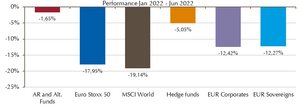Frankfurt, August 11th, 2022: Amid one of the biggest market crises since 2000, Liquid Alternatives (UCITS-compliant hedge fund strategies) delivered on their promise and demonstrated their diversification benefits compared to other asset classes in the first six months of the year. While these strategies were unable to avoid losses entirely, most were only slightly below zero as the year reached its halfway mark. Strategies with asymmetric risk-return profiles and effective ways of limiting risk generated positive returns.
With an average performance of -1.6%, liquid alternatives left the global equity markets, European bonds and unregulated hedge funds trailing in their wake in the first half of 2022.
Liquid alternatives better in a crisis
The average performance of the individual strategies in this segment ranged from -20.0% (Alt. Equity Leveraged) to +19.1% (Alt. Dedicated Short). Although the latter delivered the biggest returns, it still lags behind all of the other strategies over a three-year period, posting a negative performance during this time. While the majority of long-only strategies suffered losses for the first time in a long time, asymmetric strategies such as Alternative Managed Futures or relative value approaches generated positive returns on average.t langem mehrheitlich Verluste erzielten, erreichten asymmetrische Strategien im Durchschnitt positive Renditen, so etwa Alternative Managed Futures oder Relative-Value-Ansätze.
Funds that generated positive returns in the first half of the year were primarily characterised by their ability to effectively limit losses, with four out of five funds in this group restricting their losses to a maximum of -7.5% (“maximum drawdown”) in the first six months of 2022.
“In an environment where equity and bond markets are falling, strategies with asymmetric risk-return profiles that effectively limit losses are at an advantage,” said Ralf Lochmüller, Managing Partner and CEO of Lupus alpha. “It is vital, however, that these strategies are designed to ensure that investors can also participate in any recovery in the market after losses have occurred”, Lochmüller added.
The total volume of absolute return and liquid alternatives funds approved for distribution in Germany is EUR 256 billion. A net EUR 7.5 billion of capital flowed out of the investment universe by the middle of the year. Investor preferences were heavily influenced by the macro picture, as demonstrated by significant outflows from alternative credit strategies. While these strategies were still recording inflows in the fourth quarter of 2021, considerable uncertainty and mounting fears of a recession mean they lost almost EUR 2.7 billion in capital (-6.9%) in the first six months of the year. As a result, their share of the overall universe has dropped from 15% to just 10%. By contrast, the continual growth in the Multi Strategies category, which allows investors to position themselves more broadly on the capital markets, has been remarkable. As of 30 June, this strategy was managing almost ten percent more investor capital than it was 12 months earlier, making it the second-largest individual strategy in this segment behind Absolute Return.
This development confirms the trend away from absolute return towards liquid alternative strategies on the investor side. The share of liquid alternative strategies has grown in both absolute and relative terms every year since 2019 and has now reached around 65%, having comprised just one-third of the market ten years ago. This shift in investor preferences can be explained by the fact that alternative strategies are more diverse, allowing investors to take a differentiated approach to their portfolio to create a risk-return profile based on investor-specific requirements.
The downloadable white paper contains further detailed information, including a breakdown of the performance of individual strategies.
Download Press Relaese

![[Translate to English:] [Translate to English:]](/fileadmin/_processed_/7/1/csm_Vola-Studie_8039834ee7.jpg)
